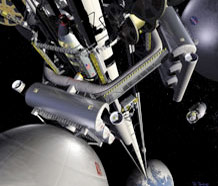A consortium of scientists and industrial firms has formulated a plan to build a space elevator that would drastically lower the cost of getting into orbit.
The Japan Space Elevator Association has published plans for the structure, which it estimates could be put in place for as little as $9bn. It would revolutionize the cost of satellite communications systems and make orbital manufacture economically feasible.
“Just like travelling abroad, anyone will be able to ride the elevator into space,” Shuichi Ono, chairman of the Japan Space Elevator Association.
The plan calls for the use of carbon nanotubes attached to a fixed platform in orbit and run down to a base station on earth. These would need to be about four times as strong as existing nanotube technology but the strength of such materials has increased a hundredfold in the last five years.
The tubes would be anchored to a fixed point in orbit and run down to a base station on earth. Elevators attached to the tubes could be powered by electricity, drastically reducing the cost of moving materials into orbit.
Orbital manufacturing has many advantages over earth based production, not least vast amounts of available solar power. Nasa has already shown the ease of growing perfect crystals in zero gravity and other exotic materials could also be produced more easily in zero gravity.
In addition, the lowered cost of getting into orbit would drastically cut the cost of setting up satellite communications systems to those parts of the world where landlines are uneconomic.
The concept of a space elevator was first conceived by Russian rocket scientist Konstantin Tsiolkovsky but was popularized by Arthur C Clarke in his book ‘The Fountains of Paradise’.

